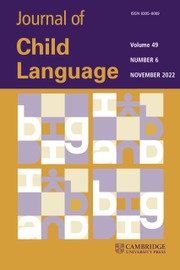Article contents
Dense home-based recordings reveal typical and atypical development of tense/aspect in a child with delayed language development*
Published online by Cambridge University Press: 06 February 2017
Abstract
Studies investigating the development of tense/aspect in children with developmental disorders have focused on production frequency and/or relied on short spontaneous speech samples. How children with developmental disorders use future forms/constructions is also unknown. The current study expands this literature by examining frequency, consistency, and productivity of past, present, and future usage, using the Speechome Recorder, which enables collection of dense, longitudinal audio-video recordings of children's speech. Samples were collected longitudinally in a child who was previously diagnosed with autism spectrum disorder, but at the time of the study exhibited only language delay [Audrey], and a typically developing child [Cleo]. While Audrey was comparable to Cleo in frequency and productivity of tense/aspect use, she was atypical in her consistency and production of an unattested future form. Examining additional measures of densely collected speech samples may reveal subtle atypicalities that are missed when relying on only few typical measures of acquisition.
Information
- Type
- Articles
- Information
- Copyright
- Copyright © Cambridge University Press 2017
Footnotes
This research was funded by the National Institute on Deafness and Other Communication Disorders (R01 2DC007428), and by ARRA Supplement 3R01DC007428-0451. We would like to thank Devin Rubin and Andrea Tovar for helping recruit families, Emily Potrzeba and Michelle Cheng for transcribing the immense dataset, and Julia Mertens for assisting in the coding of the utterances. We also thank Maria Coppola, other UCONN developmental psychology colleagues, and attendants of IMFAR 2012 in Toronto, ON and SRCD 2013 in Seattle, WA for providing helpful feedback. Finally, we are grateful for our two families that participated in this study and who agreed to have the Speechome Recorder installed in their homes. This paper was prepared from the first author's Master's Thesis.
References
REFERENCES
- 9
- Cited by


